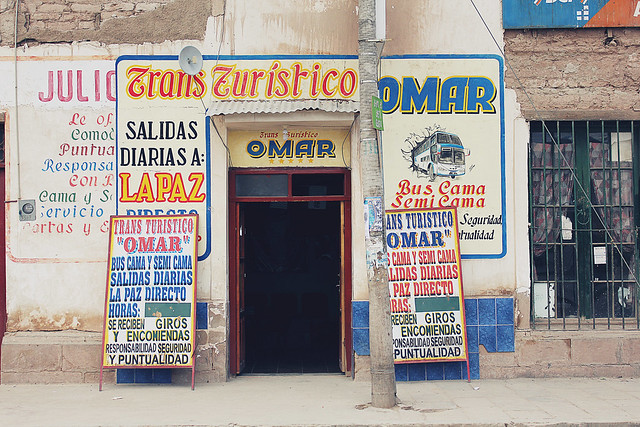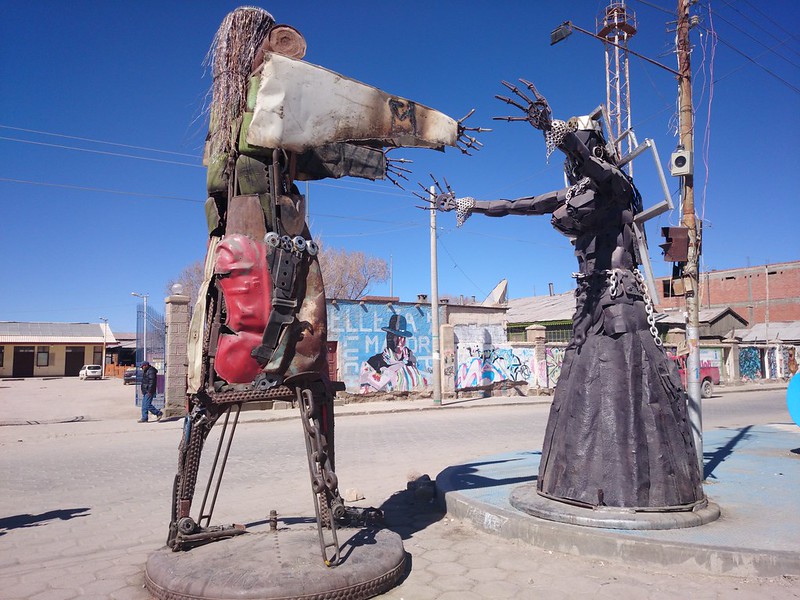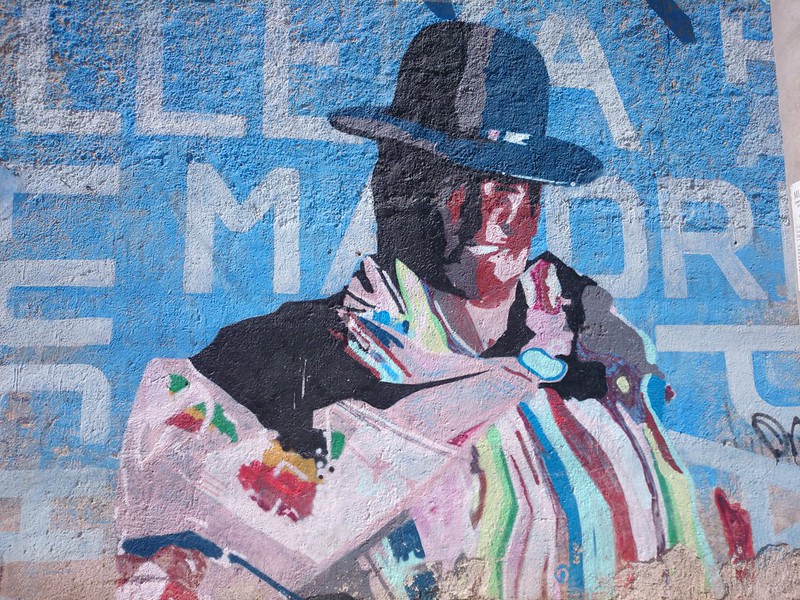As we headed back to Uyuni, following an incredible 4-day tour through the remote Bolivian altiplano, our guide regrettably informed us that we’d have to miss what was supposed to be our final stop – el cemeterio de trenes (train cemetery) – due to road blockades on the edge of town.
Apparently the only way of getting to the train cemetery from our current location was via Uyuni, and these road blockades were preventing traffic from entering or exiting the town.
Historically Bolivia has always been a country of significant social unrest, so we were well aware that travelling around the country was never going to be easy.
In fact road blockades and protests are such a common occurrence in Bolivia that the FCO offer safety and security advice surrounding them.
“Groups often use road blockades as a form of protest, without warning. Don’t attempt to cross these blockades. The Bolivian road authority website gives up-to-date information on which roads are blocked.”
But I guess I never expected to be affected by these road blockades whilst on an organised tour through Bolivia’s Salt Flats. I assumed it would happen whilst we were travelling on local transport between destinations. And I always figured that if one road was blocked then we could take another; it would simply extend the length of our journey, and would be a minor inconvenience.
I didn’t for one second think that these road blockades might prevent me from even getting into a town at which I had booked accommodation for the night, with no options to go anywhere else.
We were just five kilometres (about a 60-minute walk, our guide informed us) outside of Uyuni when we realised that our passage was blocked, and we did not have enough fuel on board to take an alternative route into the town.
Whilst it was a bit difficult to tell what was going on from the safe distance we were advised to keep (the protestors apparently have no qualms about throwing rocks at you or your vehicle), all I could see in front of us were a few cars parked up (not sure whether they were part of the blockades or whether they were people in the same situation as us), and an equal number of fairly mean-looking cholitas.
Cholitas are indigenous Aymara and Quechua women who can be identified by their heavily-layered calf-length skirts, shawls, and high bowler hats. Once maids of the middle classes who were routinely stereotyped and discriminated against, Cholitas are now very much a driving force in modern Bolivia.
You don’t mess with these women. Especially when they’re angry.
If you want an example of this, drop by La Paz on a Sunday to witness some Cholita Wrestling.
We waited there for almost two hours, our guide bravely making several attempts to negotiate with the protestors. Whilst Gloria hadn’t succeeded in getting our onward passage granted by jeep, we would be allowed to walk through with our backpacks and make the onward journey to Uyuni on foot.
Koen and Veerla decided to wait with our driver and vehicle, in the hope that the protestors would choose to disperse once the evening drew in and the temperatures dropped, and they would then be able to get to a petrol station to buy enough fuel for the onward journey to Tupiza.
However, because Stu and I ultimately needed to make it to Sucre (which was a helluva long way from Tupiza), we took Gloria up on her offer to escort us into Uyuni (where we had a hostel booked for the night) and enquire about the possibility of onward transport for us.
My full 55-litre backpack started to feel like it weighed almost twice that by the time we made it into Uyuni.
We managed to draw some cash out of an ATM in town and make it to our hostel, where the owner shook his head when we asked if there were any buses running to Sucre.
Photo via Flickr by Sebastian Lopéz
From what we could decipher, based on the snippets of information we managed to gather from our guide, the hostel owner, and workers we encountered in shops, cafes and restaurants, the reason the protesters had set up these blockades was because the authorities had failed to improve the services in Uyuni, in spite of the amounts of money that tourism was bringing into the town. All the money was going into improving the tourist infrastructure rather than looking after the residents themselves.
For this reason, commercial transport had been halted but residents were still being permitted to travel in (and refuel) their domestic vehicles.
In short, we were stranded.
If you’ve visited Uyuni, you’ll know that it’s a pretty dull, uninspiring town that offers very little to see or do (aside from the nearby Train Cemetery and Salar de Uyuni), so it’s not an ideal place to be stuck in.
However the real problem was that I had booked a course of Spanish lessons in Sucre, starting on the 21st (it was the 19th when we arrived in Uyuni) and Stu had a flight booked back to England on the 23rd (he’d been called back early to complete a contract at work). So it was kind of imperative that we made it to Sucre rather urgently.
We started researching flights from Uyuni (although in retrospect, I’m not quite sure how we were planning on getting to the airport). Only two airlines operated services from Uyuni. TAM returned no flights for the next few days, and the next available Amazonas flight was on the 22nd and cost over $600!! It would almost be cheaper for Stu to forego his international flight and book a new one!
Whilst I was desperately trying to remain optimistic, we were both getting understandably stressed and our tempers were fraying. We spent half of our time holed up in our room performing numerous internet searches, in the hope that one of them would yield the answer we were looking for, and the other half wandering the streets of the ghost town outside, searching for inspiration.
Petrol stations were closed, as were travel agents and numerous shops and restaurants. Supply routes had been severed – as, I assume, had supplies. Thank goodness for Minuteman Pizza, our sustenance saviour on that first sleepless night in Uyuni.
The next morning we decided that our only option would be to walk with our backpacks to the other side of the blockade, in the hope that we could get a lift at least part of the way if we waved enough money at someone.
So we grabbed breakfast at the hostel (luckily included in the cost of our room), met another English couple who were also trying to get to Sucre (although not with quite the same urgency as we were), and were about to check out of our room at 10:30am when there was a knock at the door.
It was one of the guys who worked at the hostel (and with whom we’d also spoken at breakfast), who informed us that he knew a lady with a jeep who was heading as far as Potosí (from where it is possible to get a bus to Sucre), BUT she was charging $300!
I guess when petrol is in high demand (and therefore prices are inflated), you have to charge accordingly. Then of course there was also the fact that she probably wasn’t supposed to be transporting tourists out of Uyuni in return for money, so she’d have to charge us enough to make it worth her while if she was stopped on route.
There were six seats in the jeep. We needed to find four other people to share the cost with. The couple we’d spoken to at breakfast would be two of them (if we could find them; we had no idea which room they were staying in), which just meant that we needed another two people.
Fortunately we found the English couple (we gave the hostel owner their names, and he tracked down their room number), and the four of us proceeded to knock on every room door in the hostel in the hope that we’d find the additional two people that we needed.
No luck.
At this rate we’d have to split the $300 fare between four of us. $75 each (£52) for a 203 kilometre journey is a lot, especially considering that the usual bus fare from Uyuni to Potosí is just 70 Bolivianos ($9.91). Besides we weren’t even sure the other English couple would be prepared to swallow the extra costs; they may have preferred to wait. We could have ended up paying even more. And whilst we had enough money aside in case of emergencies, we really didn’t want to have to use it for something like this – which was essentially to line the pockets of greedy locals taking advantage of desperate tourists.
So, our fate was in the hands of the lady who owned that jeep, and her ability to track down a further two passengers.
And just at the point that we were about to give up all hope and revert to our original plan, the guy at the hostel announced that two Japanese girls had been found and were waiting in the jeep just around the corner. We grabbed our backpacks and hot-footed it out of the hostel.
It was 13:00 and we were on the road!
Due to the fact that we weren’t strictly allowed to leave Uyuni, and all official roads out of the town had been blocked, we had to take a rather ‘interesting’ (read: off-road) route that any standard motor vehicle would simply not have been able to manage.
But I have to admit that there was something quite appealing about our very own little secret adventure. Once we were on the road and we knew we’d be able to make it to Sucre that evening, a huge weight lifted from our shoulders and we were actually able to enjoy the journey.
Both the lady who owned the jeep and the gentleman who drove us, turned out to be a lot of fun, and actually made a lot of stops along the way so that we could photograph the dramatic, cactus-dotted landscapes.


When we arrived at Potosí’s bus station, we had just an hour to wait for a bus that would transport us to our final destination – Sucre.
Ironically we arrived in Sucre just hours after we would have originally, had there been no road blockades and had we been able to get a bus directly from Uyuni to Sucre. Ok so it may have cost us five times as much to make the journey the way we eventually had to, but it could have been a lot, LOT worse.
Side note: We since learned that the others were able to get through the road blockades at around 10pm (that’s A LOT of waiting!) and were subsequently able to fuel up at a petrol station the other side of Uyuni, in order to drive back to Tupiza. They made it to Tupiza by around 3am the following morning.
Tips for dealing with road blockades
- When travelling anywhere in Bolivia, allow yourself plenty of time. Do not book any onward travel (at least not anything you wouldn’t be willing to forego) for at least a few days after you’re scheduled to arrive at your destination.
- Make sure you have plenty of cash on you. When services are severed, ATMs can run out of money quickly. Cash is required to negotiate your onward travel.
- Talk to as many people as possible about your onward travel plans. Likelihood is that word will get around, and ultimately someone will be willing to take you – for the right price.
Have you encountered any road blockades anywhere on your travels? What happened? How did you deal with them?
If you like this article, please follow along on Facebook, Twitter, or Google+ or you can look me up on Instagram or Pinterest too!











1 Comment
Leaving a comment myself in an attempt to remove the mysterious “comments closed” notification at the end of the post. Comments are not closed! Please leave a comment if you can 🙂